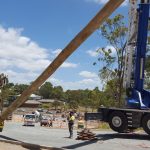
Understanding Outriggers and Stabilisers on Mobile Cranes
When it comes to mobile crane operations, stability is everything. Outriggers and stabilisers are essential components that play a critical role in preventing crane rollovers, ensuring safe lifting, and protecting workers and equipment on site.
What Are Outriggers and Stabilisers?
Outriggers are hydraulic or mechanical legs that extend from a mobile crane’s chassis to lift the wheels off the ground, widening the crane’s footprint for greater stability during lifts.
Stabilisers, on the other hand, are primarily found on vehicle-loading cranes and typically support the vehicle without lifting the wheels off the ground. Their job is to increase stability but not to the same extent as outriggers.
Key Functions and Setup
- Outriggers provide greater support during lifting operations, especially when handling heavier loads.
- Outriggers must always be set in accordance with the manufacturer’s guidelines, using full or partial extension positions as marked.
- Timbers, pads, or bog mats should be placed under outriggers to distribute the crane’s weight evenly and prevent the legs from sinking—even on hard ground.
Lifting on Partially Extended Outriggers
Only cranes that are designed and approved to lift with partially extended outriggers should do so. This setup must match the correct outrigger configuration on the load chart, and the crane should have overload interlocks in place.
Ground Pressure Considerations
The pressure applied to the ground by an outrigger varies depending on crane weight, boom length, and the load being lifted. The ground bearing capacity must exceed the pressure applied by the crane to ensure safe operation. If the ground is soft or questionable, bog mats or additional supports should be used.
Supporting Materials: Timbers, Pads, and Bog Mats
- Timber pads are commonly used and should be of sufficient size, laid side-by-side with no gaps, and wider than the outrigger foot.
- Metal and plastic pads are also used depending on the crane and site conditions.
- Bog mats are ideal for large lifts or low ground-bearing capacity areas.
If the crane manufacturer does not specify pad sizes, a competent person (such as an engineer) should determine the appropriate materials and dimensions.
Calculating Ground Pressure
Understanding ground conditions is crucial. For example, according to Safe Work Australia’s guide to mobile cranes the maximum permissible ground pressure ranges from:
- 200 tonnes/m² on hard rock
- 80 tonnes/m² on Shale rock and sandstone
- 40 tonnes/m² on compacted gravel – with up to 20% sand
- 20 tonnes/m² on asphalt
- 20 tonnes/m² on compacted sand
- 10 tonnes/m² on stiff clay (dry)
- 10 tonnes/m² on soft clay (dry)
- 10 tonnes/m² on loose sand
- Less than 10 tonnes/m² on wet clay
The highest pressure is typically applied just as the crane reaches its tipping point—with the boom directly over an outrigger.
Why It Matters
Improper use of outriggers or underestimating ground support can lead to dangerous and costly incidents. Outrigger safety is not optional—it’s a fundamental part of crane operation planning.
Need Crane Hire Help For a Safe Lift?
Mighty Cranes offers professional crane hire services in Brisbane backed by experience and a modern fleet. We understand the importance of proper outrigger setup and can help ensure your lift is safe and compliant. Call us today on 0477 000 976 for a free site visit and lift plan.
The information provided in this article is intended for general information only and should not be relied upon as a substitute for site-specific assessments or manufacturer instructions. Information in this article was sourced from https://www.safeworkaustralia.gov.au/system/files/documents/1703/guide-to-mobile-cranes.pdf




